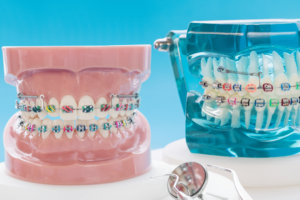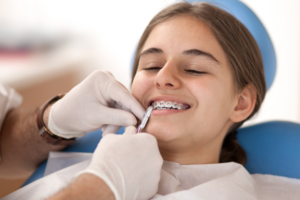Pre & Post Care
#Braces Care Guidelines:




First 24 Hours/ Immediate Instructions
- After getting your braces put on, you might feel some overall soreness in your mouth, and your teeth could be sensitive when chewing for the first few days.
- Drinking cold water can help ease discomfort because the special arch wires are sensitive to heat.
- After every meal, brush your teeth and gums meticulously, making sure to brush from every direction.
- Apply wax directly to the braces or any areas where they might be poking to minimize irritation until your next visit to the orthodontist.
General Instructions
- Use toothpaste with fluoride and apply tooth mousse around your braces twice a week.
- Add a water pick or water flosser to your daily routine after you brush your teeth.
- Rinse your mouth with warm salt water or plain water after eating.
- Steer clear of sticky, gummy, chewy, or hard foods like gum, caramels, taffy, doughnuts, popcorn, nuts, dried fruits, and ice cubes.
- When eating raw fruits and vegetables, slice them into manageable pieces.
- Soft roti is fine, but stay away from hard types.
- Choose plain ice cream without any nuts.
- If necessary, use Paracetamol to alleviate pain or discomfort; consult your Clinical Coordinator before trying any other pain relievers.
- Anticipate some irritation to your lips, cheeks, and tongue for one to two weeks as they adjust to the surface of the braces.
- If you get ulcers, seek advice from your dentist for a comforting oral gel to ease pain and burning sensations. Please get in touch with us right away if a wire breaks or if a band or bracket becomes loose so we can arrange a repair appointment. Make sure to attend follow-up appointments regularly to prevent extending the treatment duration.
- Your compliance in wearing elastics and all removable appliances is essential for the success of your treatment.
- Keep up with your orthodontist appointments for routine dental check-ups.
- Our goal is to ensure a seamless treatment process. If you have any questions or concerns regarding your treatment or medication, please don’t hesitate to contact your Clinical Coordinator.
| Post Operative Instructions forBraces./Instructions Following Braces Placement. | |
| Braces Care Guidelines: | |
| First 24 Hours/ Immediate Instructions | General Instructions |
| After getting your braces put on, you might feel some overall soreness in your mouth, and your teeth could be sensitive when chewing for the first few days. | Use toothpaste with fluoride and apply tooth mousse around your braces twice a week. |
| Add a water pick or water flosser to your daily routine after you brush your teeth. | |
Rinse your mouth with warm salt water or plain water after eating. | |
| Drinking cold water can help ease discomfort because the special arch wires are sensitive to heat. | Steer clear of sticky, gummy, chewy, or hard foods like gum, caramels, taffy, doughnuts, popcorn, nuts, dried fruits, and ice cubes. |
| When eating raw fruits and vegetables, slice them into manageable pieces. | |
| Soft roti is fine, but stay away from hard types. | |
| Choose plain ice cream without any nuts. | |
| After every meal, brush your teeth and gums meticulously, making sure to brush from every direction. | If necessary, use Paracetamol to alleviate pain or discomfort; consult your Clinical Coordinator before trying any other pain relievers. |
| Anticipate some irritation to your lips, cheeks, and tongue for one to two weeks as they adjust to the surface of the braces. | |
| Apply wax directly to the braces or any areas where they might be poking to minimize irritation until your next visit to the orthodontist. | If you get ulcers, seek advice from your dentist for a comforting oral gel to ease pain and burning sensations. |
| Please get in touch with us right away if a wire breaks or if a band or bracket becomes loose so we can arrange a repair appointment. Make sure to attend follow-up appointments regularly to prevent extending the treatment duration. | |
| Your compliance in wearing elastics and all removable appliances is essential for the success of your treatment. | |
| Keep up with your orthodontist appointments for routine dental check-ups. | |
| Our goal is to ensure a seamless treatment process. If you have any questions or concerns regarding your treatment or medication, please don’t hesitate to contact your Clinical Coordinator. | |
| Post-Composite Restoration Care Instructions | |
| You might feel some sensitivity in the treated tooth, especially during the initial 12-24 hours. | The gum tissue and injection site might feel sore for a few days because of potential irritation during the procedure. |
| It’s typical to experience sensitivity, particularly to cold temperatures, for a few days after receiving a composite filling. Typically, the deeper the cavity, the more sensitive the tooth may feel. | The finished restoration might have a slight difference in contour and texture compared to the original tooth. You may notice this slight variation with your tongue initially, but you will adjust to it within a few days. |
| You can return to your regular eating habits once the filling has completely hardened. If anesthesia was used, be careful while eating until it wears off to prevent accidentally biting your lips, cheeks, or tongue. | If you notice that your teeth don’t seem to align properly after a week or two, please get in touch with your Clinical Coordinator. This concern can usually be addressed with a brief adjustment to the filling. |
| After children undergo fillings under anesthesia, it’s important to closely supervise them until the anesthesia wears off. The numbing effect may cause some children to unintentionally chew on the inside of their lips, cheeks, or tongue, which can result in injury. | To extend the durability of your fillings, it’s important to uphold good brushing and flossing routines. Additionally, regular dental cleanings every six months, coupled with X-ray assessments, can help prolong the lifespan of your fillings even more. |
| If you have any worries or inquiries, feel free to contact your Clinical Coordinator without delay. | |
| Post Operative Instructions forBraces./Instructions Following Braces Placement. | |
| Braces Care Guidelines: | |
| First 24 Hours/ Immediate Instructions | General Instructions |
| After getting your braces put on, you might feel some overall soreness in your mouth, and your teeth could be sensitive when chewing for the first few days. | Use toothpaste with fluoride and apply tooth mousse around your braces twice a week. |
| Add a water pick or water flosser to your daily routine after you brush your teeth. | |
Rinse your mouth with warm salt water or plain water after eating. | |
| Drinking cold water can help ease discomfort because the special arch wires are sensitive to heat. | Steer clear of sticky, gummy, chewy, or hard foods like gum, caramels, taffy, doughnuts, popcorn, nuts, dried fruits, and ice cubes. |
| When eating raw fruits and vegetables, slice them into manageable pieces. | |
| Soft roti is fine, but stay away from hard types. | |
| Choose plain ice cream without any nuts. | |
| After every meal, brush your teeth and gums meticulously, making sure to brush from every direction. | If necessary, use Paracetamol to alleviate pain or discomfort; consult your Clinical Coordinator before trying any other pain relievers. |
| Anticipate some irritation to your lips, cheeks, and tongue for one to two weeks as they adjust to the surface of the braces. | |
| Apply wax directly to the braces or any areas where they might be poking to minimize irritation until your next visit to the orthodontist. | If you get ulcers, seek advice from your dentist for a comforting oral gel to ease pain and burning sensations. |
| Please get in touch with us right away if a wire breaks or if a band or bracket becomes loose so we can arrange a repair appointment. Make sure to attend follow-up appointments regularly to prevent extending the treatment duration. | |
| Your compliance in wearing elastics and all removable appliances is essential for the success of your treatment. | |
| Keep up with your orthodontist appointments for routine dental check-ups. | |
| Our goal is to ensure a seamless treatment process. If you have any questions or concerns regarding your treatment or medication, please don’t hesitate to contact your Clinical Coordinator. | |
| Post-Composite Restoration Care Instructions | |
| You might feel some sensitivity in the treated tooth, especially during the initial 12-24 hours. | The gum tissue and injection site might feel sore for a few days because of potential irritation during the procedure. |
| It’s typical to experience sensitivity, particularly to cold temperatures, for a few days after receiving a composite filling. Typically, the deeper the cavity, the more sensitive the tooth may feel. | The finished restoration might have a slight difference in contour and texture compared to the original tooth. You may notice this slight variation with your tongue initially, but you will adjust to it within a few days. |
| You can return to your regular eating habits once the filling has completely hardened. If anesthesia was used, be careful while eating until it wears off to prevent accidentally biting your lips, cheeks, or tongue. | If you notice that your teeth don’t seem to align properly after a week or two, please get in touch with your Clinical Coordinator. This concern can usually be addressed with a brief adjustment to the filling. |
| After children undergo fillings under anesthesia, it’s important to closely supervise them until the anesthesia wears off. The numbing effect may cause some children to unintentionally chew on the inside of their lips, cheeks, or tongue, which can result in injury. | To extend the durability of your fillings, it’s important to uphold good brushing and flossing routines. Additionally, regular dental cleanings every six months, coupled with X-ray assessments, can help prolong the lifespan of your fillings even more. |
| If you have any worries or inquiries, feel free to contact your Clinical Coordinator without delay. | |


